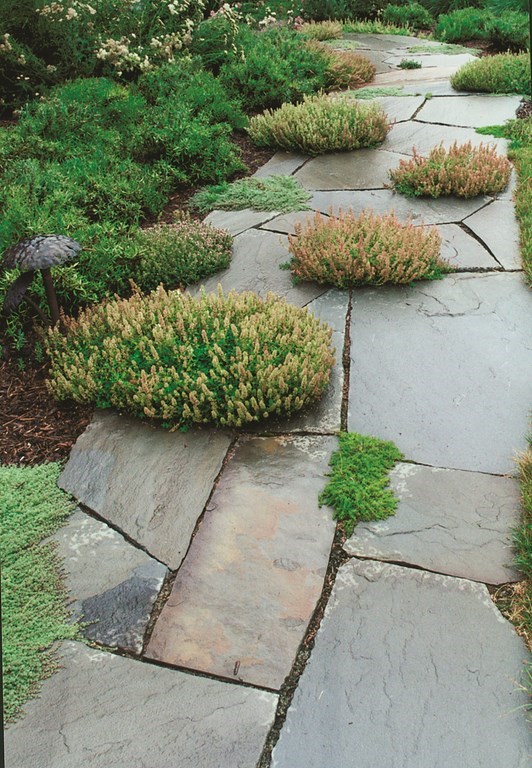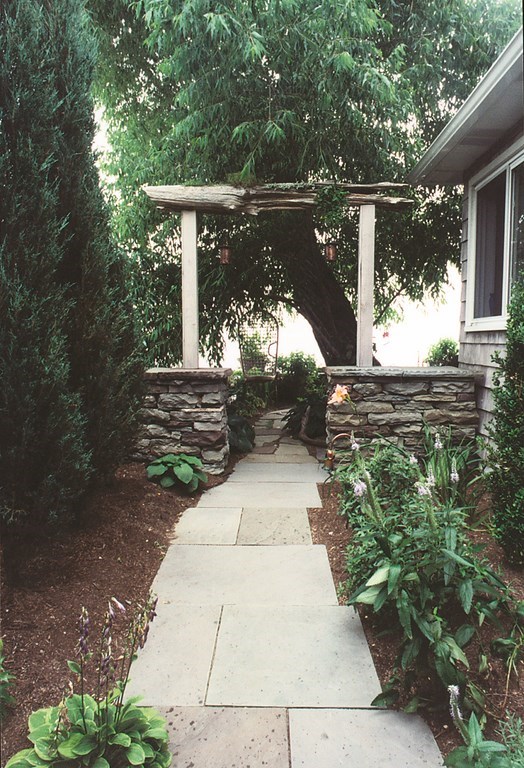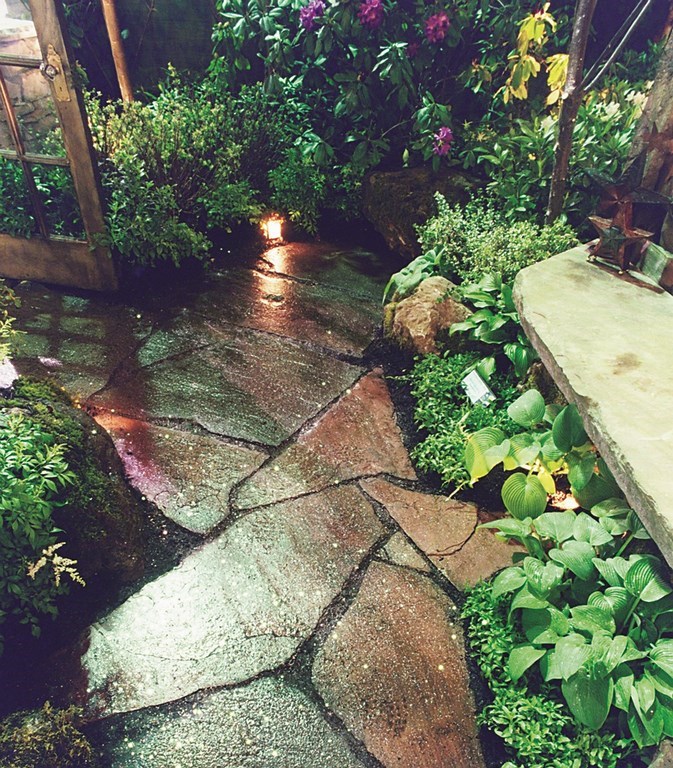Searching for Inspiration

Santiago Calatrava. Mario Salvadori. James van Sweden. Piet Oudolf. Topher Delany. Frederick Law Olmsted. Frank Lloyd Wright. Andy Goldsworthy. If these names aren’t familiar to you already, I’d suggest making an effort to find out who these people are and why I’ve listed them like this.
Some are icons in the history of architecture and design, and certainly all of them have inspired many of us in the landscape trades to reach beyond our boundaries. Personally, these gifted artists have long served as primary sources of inspiration and have always fueled my creativity.
Inspiration flows from many sources, of course – maybe from a project you’ve seen in print or a particularly beautiful piece of stone you’ve held over from a previous job or an incredible vista you wanted to frame. The possibilities are endless, and the sources are different for everyone. Some are inspired or motivated purely by money, others are driven by the desire to become famous. Still others can’t really pinpoint what it is that inspires them.
Wherever we find it, inspiration is individualized. My office, for example, overlooks a pond the design of which was inspired by my many forays into nature. Gazing out over it reminds me daily of that inspiration and is one of those things that feeds my ideas and motivates me to spend long hours to reach my pinnacle as a designer.
PLANTING THE SEED
I didn’t always have this outlook on my professional life. I now see that I came to a real turning point at a Whispering Cranes Institute design conference I attended years ago. I had arrived as a typical landscape installer in a quest for inspiration, but I had few expectations.
On hand at the conference was David Slawson, an expert in Japanese garden design whose book, Secret Teachings in the Art of Japanese Garden Design, is among the most influential of all available resources. After the conference, I handed him my copy and he inscribed this passage: “You may not say you’re an artist, but you can no longer say you’re not.”
From that point forward, I was inspired to open my eyes to the endless possibilities waiting for me as an artist in the medium of landscape design. It was a defining moment in my career: I left the conference inspired to create, not just install, and began seeing the world around me in a new way – nature, museum exhibits, other designers’ work, the architecture all around me.
My creativity had begun flowing like a river, and it hasn’t stopped since.
I want to pass David Slawson’s message along to you in this and future installments of “Inspired Designs.” I want to encourage you to open yourself up to ideas both new and old and allow yourself to become an artist, think beyond your comfort zone and allow yourself to be inspired by other designs and designers.
It’s all about opening your eyes, heart and mind to ideas you may never have considered before – or maybe you have, but were too insecure or bound by what you’d always done to take the next step and apply the inspiration you’d received.
Time and again we hear of great artists who acknowledge that they themselves have been inspired by work that has come before. James van Sweden, considered one of the premier landscape architects of his generation, says that he draws much of his inspiration from old paintings and art. Frank Lloyd Wright, among history’s greatest architects, rhapsodized about simple principles of Japanese design and the prairie that surrounded him in childhood.
It’s all about opening our eyes, taking in what we see and thinking about elements of our personal landscapes in new (or maybe old?) ways.
PRACTICAL ADAPTATION
It’s been said more than once that there are no new ideas, only recycled ones. Perhaps that leads to a sense of futility on some designers’ parts (although I, for one, think there are concepts and approaches out there that have yet to be discovered or defined), and perhaps it explains the pervasiveness of a feeling in the landscape industry that keeps so many professionals from straying off familiar paths.
 It’s true: A huge number of companies – designers and installers alike – stick to using identical materials and repeating design details on just about all of their jobs. Some are caught by the fact that they’re authorized contractors locked into using a particular product, but even those not restrained by such an obligation tend too often to use the same set of materials, ideas and plants no matter whether the home is in an English Tudor, Federal Colonial, Greek Revival or Prairie style.
It’s true: A huge number of companies – designers and installers alike – stick to using identical materials and repeating design details on just about all of their jobs. Some are caught by the fact that they’re authorized contractors locked into using a particular product, but even those not restrained by such an obligation tend too often to use the same set of materials, ideas and plants no matter whether the home is in an English Tudor, Federal Colonial, Greek Revival or Prairie style.
And when you ask them why they do things that way, you’ll more than likely hear, “That’s the way we’ve always done it.”
Most likely, these folks are making money by cranking out assembly-line-type work and find success and satisfaction in being efficient or fast or inexpensive. Personally, I kind of like having these operations around because they make me look incredibly creative by comparison, but the more important point is, despite the competitive edge they give me, these operations do absolutely nothing to boost the image or enhance the reputation of my chosen profession.
Ultimately, boosting and enhancing the landscape industry is what this column is all about: I hope this column will motivate and challenge every one of you – even the most inspired achievers among you – to take big steps and reach beyond your comfort zones.
My goal, in short, is to inspire you to take a studied, yet critical view of the greater possibilities.
That’s my approach, and I see every new design project I undertake as presenting me with the opportunity to evaluate new potentials and stretch my design abilities. Where I live, in the Finger Lakes region of New York, I am challenged by a general clientele with limited budgets and the necessity of working with a 42-inch-deep frost line, but for years I have never let myself be shackled or hamstrung by those challenges or given a project less than my creative all.
SHARING EXPERIENCE
I know I am not alone in thoughtfully considering how to create great landscapes for modest sums of money, nor am I alone in facing regional or climatic issues that can be awesomely discouraging at times. These constraints, I think, press me to more creative designs and inventive construction solutions that accomplish great beauty without expanding the budget.
I will share some of these experiences in future columns to help you think about approaches to projects that will generate results that you’ll be proud to include in your portfolio and show off to your family, friends and potential clients.
 I will also explore commonsense issues: Why this plant, this brick, this type of stone? Understanding and working through these basic rules and principles has always helped me think about things clearly and helped me arrive at more fully developed design choices.
I will also explore commonsense issues: Why this plant, this brick, this type of stone? Understanding and working through these basic rules and principles has always helped me think about things clearly and helped me arrive at more fully developed design choices.
In doing so, I can’t or won’t be prescriptive, because every project, every setting, every client is different. Instead, what I will discuss is patterns of consideration and offer them as resources you can vary and apply in whatever way works for you. There are indeed many acceptable ways to meet clients’ needs and expectations!
We’ll also be covering proper construction techniques, which I consider to be critical for project success. We’ll visit job sites, dissect design decisions, examine site challenges and discuss how we dealt with these challenges as a means of inspiring you to view each of your projects from different vantage points.
Occasionally we’ll look in on failures, because studying projects gone awry can be a great learning tool that will help us make better choices in the future. Why did that retaining wall fail or those trees die? Why has water flooded the basement and where is it originating? Such events plague companies in our industry every single day.
In fact, my company is often summoned to examine previously installed projects, and some people have taken to referring to us as “forensic landscapers.” When we find bad jobs, we do all we can to rectify situations and turn a job that reflects poorly on all of us in the landscape trades into something that regains consumer trust and confidence.
Ultimately, that’s what it’s all about: Client perception is critical to both our development as an industry and our success individually. It doesn’t matter what we do for our clients, it matters what they think of what we do, which means that every company should perform quality installations, every time.
AIMING FOR THE FUTURE
If everyone aspires to and is in fact held to a higher standard, then we are all driven to do better. If we develop along the way a little friendly, upwardly striving competition within our ranks, so much the better, because that will enable us to elevate our collective creativity level and constantly improve our industry.
Some see the landscape business as the runt of the construction-related trades and dismiss us as lawn-cutters and weed-pullers. All too often, we fall into the trap of thinking that way ourselves as we progress through the trades and take on increasingly complex assignments.
Take the case of a firm that, before it is ready or qualified to do so, overreaches and builds a critical retaining wall without consulting an engineer or architect. When the house slides down a hill, great harm is done to the reputation of every landscape-related business. As I see it, prevention through information is the key: My column is dedicated to that purpose – and so is the rest of the magazine, in every issue.
My task is to raise general awareness of architecture, art, clients’ idiosyncrasies, materials old and new, great designers and much more. Whether you agree or disagree with my commentaries, the value is in the discussion, the sharing of ideas and the case studies that lead to a deeper understanding of how we can elevate our profession and integrate these ideas into our work.
The first time we think we have reached the peak of our profession, we do ourselves a disservice: There will always be someone or something that can drive us to new heights. Simply put, there is always more!
Bruce Zaretsky is president of Zaretsky & Associates, a landscape design/construction company in Penfield, N.Y. Since starting in the landscape design industry in 1979, Zaretsky and partner Sharon Coates have become nationally recognized for their creative and inspiring landscapes, gardens and waterfeatures in projects ranging from the smallest residential spaces to sweeping landscapes. They’ve recently placed emphasis on conceiving and installing healing and meditation gardens for health-care facilities, nursing homes and hospitals.










